Abstract
The intercooler is a crucial component of the rich gas compressor. Due to the shortcomings of the conventional segmental baffle intercooler, an optimization design of the novel industrial-grade twisted-elliptic-tube intercooler is proposed. This study aims to compare the heat-transfer performance of these two types of intercoolers in a delayed coking unit at Sinopec. During the plant revamp operation, the original segmental baffle intercooler was replaced by the novel twisted-elliptic-tube intercooler. Experimental determination and comparison analysis of the industrial locale operation of the two types of intercoolers before and after the revamps were conducted. The evaluation results show that the novel twisted-elliptic-tube intercooler has a higher cooling capacity, with a 13.2% increase, compared to the conventional intercooler. Under identical operating conditions, the overall heat-transfer coefficients increase by 87.8%. Moreover, the heat-transfer area and gas pressure drop decrease by 37.4% and 36.9%, respectively. The tube bundles’ vibration and loud noise problems of the old intercooler are eliminated. The average exit temperature of the enriched gas that requires cooling is 38.4 °C, which is 7.3 °C lower than that of the conventional intercooler. These outcomes indicate that utilizing this innovative twisted-elliptic-tube heat exchanger can provide substantial advantages in terms of high heat-transfer efficiency and exceptional anti-vibration performance.
1. Introduction
Petrochemical plants are often considered for the renovation and upgrading of current equipment. According to the statistics, more than 35–40% of types of heat exchangers used in industrial areas are of the shell-and-tube heat exchanger variety [1,2,3]. The intercooler as a core heat exchanger of the multiple-stages rich-gas-compressor system is used to cool the compressed gas between the stages for the delayed coking unit. With intercooling, the compression process is closer to an isothermal compression process, resulting in lower power requirements [4]. As industrial equipment tends to be larger and more efficient, the performance of the intercooler directly affects the safety and efficiency of the gas compressor. The conventional shell-and-tube heat exchanger with segmental baffles is the most commonly used intercooler type. However, this type of heat exchanger has poor heat-transfer efficiency, large pressure drop, vibration risk of tube bundles and other shortcomings [5,6,7].
Research into enhanced heat-transfer technologies has therefore always been an important issue [8,9]. Kumar et al. [10] analyzed the material, shape and thickness of the fin of the tubes in intercoolers using Taguchi’s design of experiments based on ANSYS software. Sathyaraj et al. [11] modified the existing finned intercooler by inserting the circular cross-section pins normal to the flow direction of air in an existing intercooler and used CFD software to analyze the newly designed intercooler. Chen et al. [12] exploited the corrugated tube to replace the circular tube and studied the performance of the corrugated-tube natural gas compressor intercooler. Yu et al. [13] used the numerical method to compare the j/f evaluation factors of fin unit bodies of intercoolers that had straight fins versus rectangular misaligned fins. Most of the current studies were based on the tube-side performance improvement of the intercooler, while the baffles were still adopted in the shell side to support tube bundles. Though the heat-transfer coefficient has been augmented, the disadvantages of tube bundle vibration, more material consumption, and large shell-side pressure drop are still left unresolved.
Heat exchangers are considered critical components in energy conversion. As China’s dual-carbon target is put forward, there is an urgent need to develop more newly high-efficiency and safe heat exchanger equipment for industrial applications [14,15,16]. Some researchers indicate that the longitudinal flow in the shell side is the most ideal pattern of flow in the shell-and-tube heat exchanger [17]. The twisted-elliptic-tube heat exchanger is a representative of longitudinal flow heat exchangers by using enhanced heat-transfer tubes. When twisted elliptic tubes are arrayed in the same direction, the tube bundles realize self-supporting by themselves with a baffle-free structure in the shell side. Owing to its enhanced heat-transfer performance, convenient manufacturing, low cost and reliable operation without tube bundle vibration, the twisted-elliptic-tube heat exchanger has received widespread attention. During the initial phase of research, Asmantas et al. [18] and Dzyubenko et al. [19] conducted experiments on the properties of twisted elliptical tubes in order to establish the correlations of heat transfer and flow friction. Tan et al. [20] and Bishara et al. [21] conducted experimental and numerical research on the turbulent heat-transfer process on the tube side of the twisted elliptic tube and analyzed the mechanism of enhanced heat transfer by using field synergy theory. Yan et al. [22] also obtained satisfactory results when studying the use of twisted elliptical tubes to intensify epoxy heat transfer. Optimization designs of twisted-elliptic-tube heat exchangers were investigated according to shell-side thermal-hydraulic characteristic of the twisted-elliptic-tube heat exchanger [23]. Liu et al. [24] found that the shell-side heat-transfer coefficient per unit pressure drop of the twisted-elliptic-tube oil cooler is larger than traditional heat exchangers with segmental baffles. Mo et al. [25] studied the heat-transfer and fluid flow performance of the twisted elliptic tube in the gas–solid two-phase flow environment. Al-Hadhrami et al. [26] evaluated the performance of a twisted-elliptic-tube heat exchanger of an existing naphtha hydrotreating plant. Tu et al. [27] designed a novel closed evaporative cooling tower with twisted elliptic tubes. The results show that the overall cooling performance increased by 7.31% on average. Li et al. [28] used 3D simulation methods to investigate the heat transport enhancement performance of twisted elliptic tubes.
Upon analysis of the available literature, though the twisted tube heat exchanger has had a good energy-saving and material-saving effect, there are few research reports on twisted-elliptical-tube heat exchangers for practical industrial applications. The majority of the studies regarding twisted-elliptic-tube heat exchangers are limited by their small size and experimental nature, hindering their further applications in the energy industry. A novel twisted-elliptic-tube intercooler is developed as a viable alternative solution for industrial applications. The aim of this study is to compare the heat-transfer performance of the twisted-elliptic-tube intercooler and the conventional segmental baffle intercooler of a delayed coking unit with a capacity of 1 million tons per annum for Sinopec. And both intercoolers are practical products. The working fluids of the shell side and tube side of the intercoolers are rich gas and cooling water. The heat-transfer performance of these two intercoolers is investigated using an industrial locale experimental method.
2. The Structure and Characteristic of Twisted-Elliptic-Tube Heat Exchanger
The twisted elliptic tubes are manufactured by our research group. Special techniques are used to transform the circular tubes into an oval section with a twist overlay. A sketch of the twisted elliptic tube is given in Figure 1a. Geometry parameters of the twisted elliptic tube are twist pitch (S), major axis (A) and minor axis (B) of the oval section. The twisted-elliptic-tube heat exchanger can avoid the need for baffles in the shell side. For instance, when arranged in a square pattern, the tube bundle is supported by the convex of tubes themselves. The tube bundle forms a grid-like integration structure, as shown in Figure 1b. In this special structure, each twisted elliptic tube is firmly and frequently supported by at least four adjacent tubes in every half-twist pitch. Normally, the tube bundle is tied up by steel belts to further intensify the rigidity in the twisted-elliptic-tube heat exchanger during assembly.
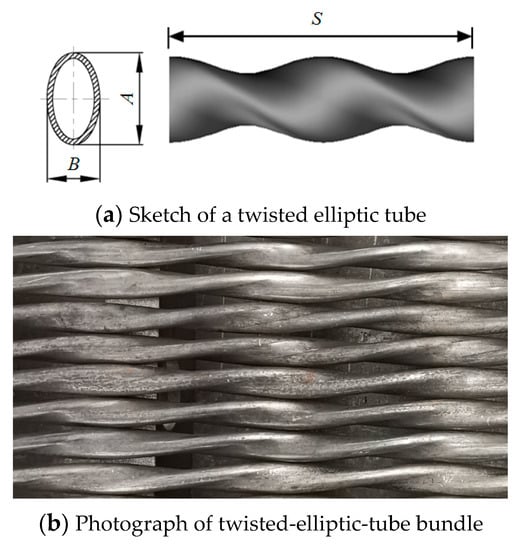
Figure 1.
Schematic diagram of the twisted elliptic tube.
Figure 2 illustrates that the shell-side fluid of the twisted-elliptic-tube heat exchanger experiences a change from a conventional zigzag flow to a longitudinal spiral flow along tube bundles while being compared with conventional segmental baffle heat exchangers.
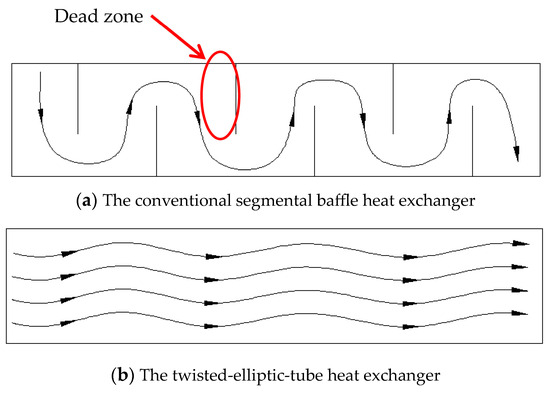
Figure 2.
Two kinds of shell-side flow pattern of different heat exchangers.
3. Description of Existing Rich-Gas-Compressor Intercooler
The tube bundle of a conventional rich-gas-compressor intercooler used in a delayed coking unit with 1 Mt/a vibrates violently and makes loud noises when operated in large gas situation, which causes safety risks in the compressor system. During summer days, the cooling capacity of the intercooler is unsatisfactory, and the gas outlet’s maximum temperature is nearly close to 50 °C, which greatly exceeds the design requirements. This operating condition affects the safety and efficiency of the gas compressor. The design parameters of the rich-gas-compressor intercooler are shown in Table 1.

Table 1.
Design parameters of the rich-gas-compressor intercooler.
4. Description of a Novel Twisted-Elliptic-Tube Intercooler
4.1. Feasibility
Usually, water is adopted as the coolant to cool the compressed gas. Hence, the intercooler is actually a gas–water heat exchanger. Due to the massive distinction of the density and heat capacity between the gas and water, the gas volume is much larger than the water volume. Normally, the gas goes through the shell side, while the water passes through the tube side. Based on theoretical analysis, the heat-transfer coefficient of the gas and water differs greatly in the heat-transfer process. In general, the heat-transfer coefficient of the low- and medium-pressure gas is about 50–200 W·m−2·K−1, while on the water side, it can reach to almost 3000–10,000 W·m−2·K−1 [29]. Thus, heat-transfer resistance is mainly focused on the air side. According to the heat-transfer-enhancement theory, to gain a high overall heat-transfer coefficient, we should figure out ways to improve the heat transfer coefficient of air. Generally, two methods are used to enhance the air side heat transfer by increasing the air velocity or by using a finned tube, although these two methods are not cost-effective. Firstly, the gas pressure drop is strictly restricted in the design of a compressor intercooler to low the power consumption of the gas compressor. The gas pressure drop will rise rapidly with the increase in air velocity in a conventional segmental baffle intercooler, thus leading to the decrease in gas compressor efficiency. Secondly, using finned tubes costs more material, and the loosening of the fins increases the thermal resistance of contact. Also, the corrosion of fins will reduce the heat-transfer performance of the intercooler.
The twisted-elliptic-tube heat exchanger can effectively resolve the above problems. The twisted elliptic tube is a kind of enhanced heat-transfer element with a smooth surface and no fin. The section of the twisted elliptic tube is fabricated into an oval section from the round tube, which means the tube-side space is transferred to the shell-side space. As a result, the tube-side space becomes smaller, while the shell-side space becomes larger. Furthermore, the flow area on the inner and outer side of the intercooler can be adjusted flexibly by controlling the twisted-elliptic-tube flattening ratio. Because the volume flow rate of gas is much larger than the water flow rate, through this variable flow space adjustment, the different demands on the space size of the gas–water heat-transfer process are better matched. Therefore, the twisted-elliptic-tube intercooler can reduce the shell-side pressure drop at the same volume flow rate compared with conventional segmental baffle heat exchange. In addition, due to the special structure of the twisted-elliptic-tube bundle, the heat-transfer process of the tube side and shell side of the twisted-elliptic-tube intercooler is enhanced simultaneously.
4.2. Configuration
The diagram of the twisted-elliptic-tube intercooler is presented in Figure 3. The twisted-elliptic-tube bundles are arranged in a square pattern, self-supported by an adjoining tube. In this study, the twisted-elliptic-tube intercooler has two shell pass and four tube passes. A deflector structure and bulkheads are provided to avoid leakage flow on the shell side of the twisted-elliptical-tube intercooler. The geometry parameters of the conventional circular-tube intercooler and the twisted-elliptic-tube intercooler are shown in Table 2.
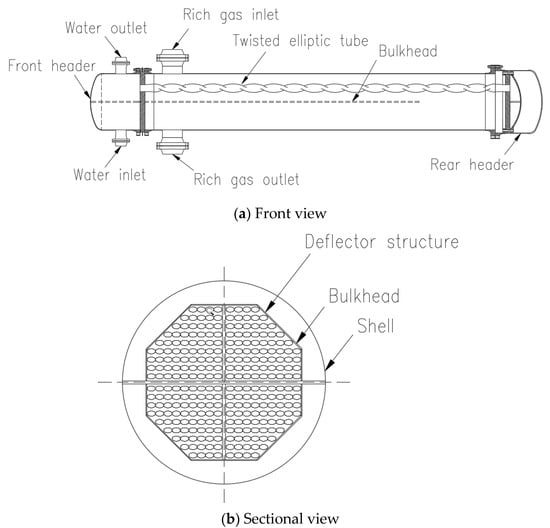
Figure 3.
Schematic diagrams of the twisted-elliptic-tube intercooler.

Table 2.
Geometry of two different intercoolers.
5. Industrial Locale Experimental Setup and Measurement Method
According to the operating conditions, a novel twisted-elliptic-tube intercooler was designed to replace the original segmental baffle intercooler during plant revamp operations. The schematic diagram of the industrial locale experimental setup and test points are presented in Figure 4. The industrial locale experimental system mainly consists of one rich gas multistage compressor, one rich gas intercooler and one buffer tank. The low-pressure rich gas is sucked into the compressor. After the first-stage compression, the temperature and pressure of the rich gas rise to a certain value. Then, the compressed rich gas flows into the shell-side of the intercooler and is cooled down by the tube-side water. The cooled rich gas enters the buffer tank and is then re-sucked into the compressor for second-stage compression to become a high-pressure rich gas. The cooling water comes from the cooling tower in the plant. After absorbing the heat released by the rich gas, the warmed-up cooling water is pumped back to the cooling tower to cool down. The rich-gas-compressor intercoolers are instrumented to record the bulk temperatures, volume flow rates and pressure drops at the shell-and-tube sides of the intercoolers before and after installation of the twisted-elliptic-tube heat exchangers. During the test period, the operating flow rate of rich gas is between 10,400 and 12,200 Nm3/h. The operating inlet temperature of the rich gas is between 110 and 120 °C. The operating inlet temperature of the cooling water is between 32 and 35 °C. Platinum resistance thermometers with an accuracy of ±0.15 °C are used to record the temperatures of the gas/cooling water. To monitor the volume flow of gas/cooling water, two flow meters with an accuracy of ±0.5% are mounted on the supply gas and water pipes. The pressures are detected by pressure transmitters. The accuracy is ±0.5%. Data were collected daily for one month prior to and one month after installing the twisted-elliptic-tube intercooler. All the recorded signals were connected to the DCS system.
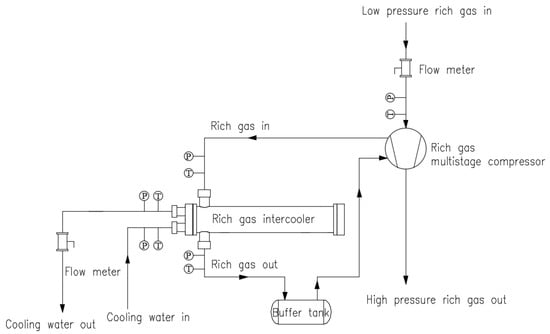
Figure 4.
Schematic diagram of the industrial locale experimental setup and test points.
6. Data Reduction
The following equations were used to calculate the cooling capacity:
Here, and represent the gas and water heat-transfer capacity, respectively; represents the average heat-transfer capacity; and indicate the gas and water density, respectively; and represent the gas and water flow rate, respectively; and denote the gas and water specific heat, respectively; and represent the gas inlet and outlet temperature, respectively; and and refer to the water inlet and outlet temperature, respectively. Arithmetic averages of inlet and outlet temperature are used as reference temperatures to compute physical quantities.
The overall heat-transfer coefficients were determined using the following formulae:
In this context, refers to the overall heat-transfer coefficient; stands for the log mean temperature difference (LMTD); represents the heat-transfer area; is the LMTD correction factor; denotes the number of tubes; indicates the outer diameter of the tube; and represents the length of the tube.
The experimental uncertainty was computed using the Moffat [30] and Kline [31] method. According to the accuracy of the test instruments and data reduction method, the maximum relative uncertainties of Q and k for all the data are ±3.08% and ±3.31%, respectively. All uncertainties are acceptable for engineering applications.
7. Results and Discussions
Figure 5 is the picture of the twisted-elliptic-tube intercooler in assembly. As can be seen, no baffle is needed in the shell side of the twisted-elliptic-tube heat exchanger. In a conventional segmental baffle intercooler, the tube bundles are subjected to fluid-induced vibration through vortex detachment, turbulence flutter, and fluid elasticity perturbation excitation due to the transverse flow [32]. However, the shell-side fluid of the twisted-elliptic-tube heat exchanger changes from the traditional transverse flow to a longitudinal spiral flow along tube bundles without zigzagging. Furthermore, the multi-point self-support structure reduces the tube span and intensifies the stiffness of the tube bundle. Each twisted elliptic tube is “locked” in place by adjacent tubes. In this twisted-elliptic-tube intercooler, there exists about forty tube-to-tube contact points along the entire length. This tube bundle support system eliminates the possibility of any tube movement. These two characteristics avoid the damage caused by tube bundle vibration and improve the safety of the intercooler. The actual operation analysis showed that the vibration of the tube bundles and the loud noises were eliminated. The resonance phenomenon of the heat exchanger base and the connecting pipe also completely disappeared. This indicates that use of the twisted-elliptic-tube intercooler could reduce the risk of equipment failure and extend the service life of the device in the industry.
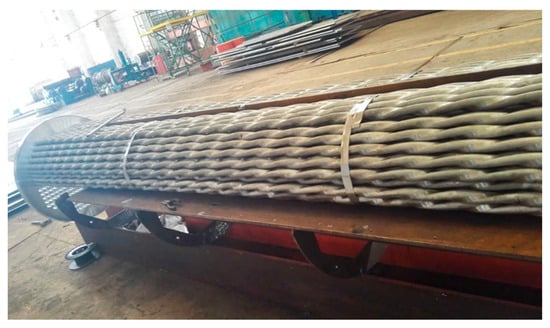
Figure 5.
Picture of assembling of the twisted-elliptic-tube intercooler.
The installations before and after revamps of the intercoolers are shown in Figure 6. As can be seen, the equipment base and floor area do not need to be changed before and after the renovation. The inlet and outlet of the shell-side gas of the twisted-elliptic-tube intercooler are located on the same side. The gas and water are close to a pure countercurrent flow, which improves the effective heat-transfer temperature difference. Due to the pure countercurrent flow, the heat-transfer temperature end difference can be reduced, and the heat-transfer efficiency is comparable to that of plate heat exchangers. This is impossible to achieve in conventional segmental baffle coolers.
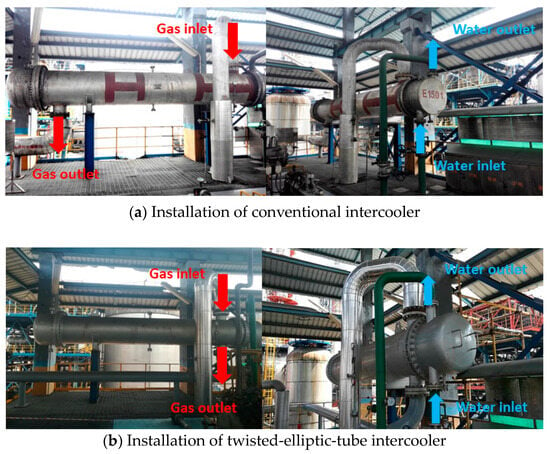
Figure 6.
Installations before and after revamps.
The cooling capacity of the segmental baffle intercooler and twisted-elliptic-tube intercooler is given in Figure 7. Before installing the twisted-elliptic-tube heat exchanger, the average daily cooling capacity of the segmental baffle intercooler was 682.8 kW. The cooling capacity was increased to 773.1 kW after the twisted-elliptic-tube intercooler was upgraded by substituting the previous conventional intercooler. An increase of 13.2% in cooling capacity was obtained with a 37.4% reduction in the heat-transfer area of the twisted-elliptic-tube intercooler. According to the results, the twisted-elliptic-tube intercooler is more efficient compared with the segmental baffle intercooler. The reasons for the increase are listed below. Firstly, the shell side of the twisted-elliptic-tube intercooler has no flow return or short circuit. Moreover, the shell-side fluid distribution is more uniform. There are no flow “dead zones”. This results in a significant increase in the effective heat-transfer area. In addition, the heat-transfer enhancement of the twisted elliptic tubes results in a higher overall heat-transfer coefficient.
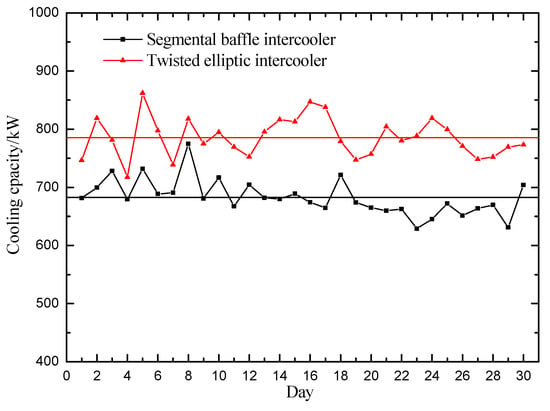
Figure 7.
Comparison of cooling capacity of segmental baffle intercooler and twisted-elliptic-tube intercooler.
Figure 8 presents the comparison of the overall heat-transfer coefficient of the segmental baffle intercooler and the twisted-elliptic-tube intercooler. It can be seen that the average overall heat-transfer coefficients of these two intercoolers are 320.2 W·m−2·K−1 and 170.5 W·m−2·K−1, respectively. The overall heat-transfer coefficient of the twisted-elliptic-tube intercooler is larger than that of the segmental baffle intercooler by an average increase of 87.8%. The following are the reasons for the heat-transfer enhancement performance of the twisted-elliptic-tube intercooler. Firstly, altering the collision flow field of the conventional segmental heat exchanger to a friction flow field of the twisted-elliptic-tube intercooler with baffle-free design reduces the local pressure drop of the gas side and enhances the ‘heat-transfer–pressure drop’ performance. Nearly the entire shell-side pressure drop is applied to the heat-transfer surface of the twisted elliptic tubes, thereby reducing the flow boundary layer and improving heat transfer. Furthermore, the neighboring tube bundle is self-supported at the contact points of the twisted-elliptic-tube bundles, resulting in a more condensed arrangement compared to the segmental baffle intercooler. In this way, the fluid’s turbulence can be intensified by increasing gas velocity, without a substantial increase in the pressure drop. Secondly, the flow distribution and velocity across the entire tube bundle are more consistent due to the longitudinal spiral flow on the shell side. The complex swirl flow enhances the fluid turbulence. Furthermore, the centrifugal force generated when the gas goes through the spiral channel causes a radial pressure gradient along the tube bundle. Due to the radial pressure gradient, the heavier cold gas tends to exit the tube bundle, while the lighter hot gas tends to adjoin the tube bundle. This situation promotes radial mixing of the fluids, intensifying the turbulence in the fluid boundary layer. Similarly, the fluid on the tube side generates an intense rotary motion that reinforces the radical mixing process and destroys the boundary layer. Consequently, the heat-transfer performance of the twisted elliptic intercooler is enhanced. The increased value of the overall heat-transfer coefficient resulted in an increased cooling capacity and a reduction in the heat-transfer area of the novel twisted-elliptic-tube intercooler.
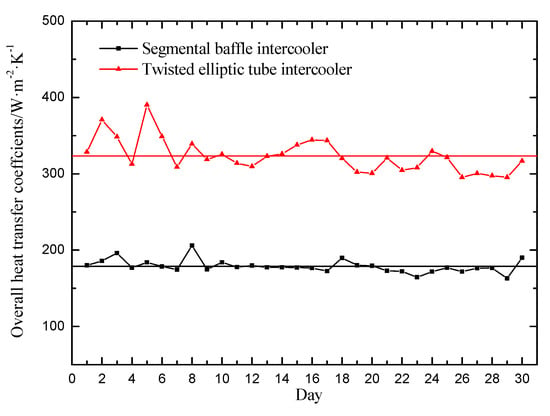
Figure 8.
Comparison of overall heat-transfer coefficient of segmental baffle intercooler and twisted-elliptic-tube intercooler.
The comparison of the rich gas outlet temperature of the segmental baffle intercooler and that of the twisted-elliptic-tube intercooler is shown in Figure 9. It can be seen from Figure 9 that the twisted-elliptic-tube intercooler has a significantly lower gas outlet temperature compared to the conventional intercooler. Quantitively, the gas outlet temperatures of the twisted-elliptic-tube intercooler are all below the 40 °C bases, and the average temperature is 38.4 °C, while the average gas outlet temperature of the conventional intercooler is 45.7 °C. The small cold-end temperature difference indicates that a better cooling effect has been achieved and the design requirements are reached by using the twisted-elliptic-tube intercooler. The lower rich gas outlet temperature is beneficial to reducing the energy consumption of the rich gas compressor. The smaller cold-end temperature difference in the twisted-elliptic-tube intercooler is a result of the pure countercurrent flow and heat-transfer enhancement.
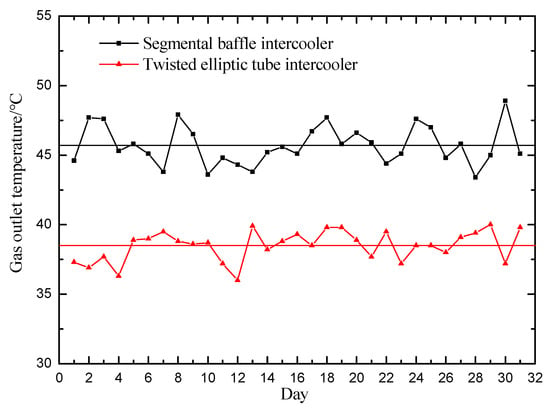
Figure 9.
Comparison of rich gas outlet temperature of segmental baffle intercooler and twisted-elliptic-tube intercooler.
Table 3 summarizes the intercoolers’ thermal performance data before and after revamps. It is observed that under the same operating conditions, the performance of the twisted-elliptic-tube heat intercooler has a 37.4% decrease in heat-transfer area and a 36.9% reduction in gas pressure drop compared with the conventional circular-tube intercooler. In the tube side, due to the velocity increment and the special spiral passage, the heat transfer is intensified as pressure drop increases by 39.7%, while the water pressure drop is still within the allowable pressure drop of the design. The results show that the twisted-elliptical-tube heat exchanger can effectively reduce material consumption. It also has a lower shell-side pressure drop.

Table 3.
Comparison of thermal performance between different intercoolers.
8. Conclusions
In the present paper, a novel twisted-elliptic-tube intercooler was designed. The heat-transfer performance of the conventional segmental baffle intercooler and the twisted-elliptic-tube intercooler are experimentally investigated and compared, and both intercoolers are practical products that are applied in the delayed coking unit for Sinopec. Through the analysis, the following conclusions are drawn:
- (1)
- Compared with the conventional intercooler, the twisted-elliptic-tube intercooler has a higher cooling capacity by an increase of 13.2%. Under the same operating conditions, the overall heat-transfer coefficients enhance by 87.8%. And the heat-transfer area and gas pressure drop are reduced by 37.4% and 36.9%, respectively.
- (2)
- The tube bundles’ vibration and loud noise problem of the segmental baffle intercooler are eliminated by the use of the twisted-elliptic-tube intercooler. The average outlet temperature of the rich gas is 38.4 °C and meets the design requirement well, which is 7.3 °C lower than that of the conventional intercooler. The twisted-elliptic-tube intercooler can improve the safety and efficiency of the gas compressor.
- (3)
- An application of this innovative twisted-elliptic-tube intercooler could result in considerable benefits in terms of good anti-vibration, a higher heat-transfer coefficient, lower shell-side pressure drop and material saving.
Author Contributions
Conceptualization, S.L. and D.Z.; methodology, A.T.; validation, A.T.; formal analysis, S.L. and Y.L.; investigation, S.L. and A.T.; data curation, Y.L. and S.L.; writing—original draft preparation, S.L.; writing—review and editing, S.L. and A.T.; project administration, A.T. and D.Z.; funding acquisition, D.Z. All authors have read and agreed to the published version of the manuscript.
Funding
This work is funded by the National Key R&D Program of China (No.2022YFB4202001); Special Cooperation Program of Jilin Province and Chinese Academy of Sciences (No. 2022SYHZ0027); Science and Technology Commissioner of Guangdong Province (No. GDKTP2021047200).
Data Availability Statement
The data presented in this study are available upon reasonable request.
Conflicts of Interest
The authors declare no conflict of interest.
References
- Master, B.I.; Chunangad, K.S.; Pushpanathan, V. Fouling mitigation using helixchanger heat exchangers. In Proceedings of the ECI Conference on Heat Exchanger Fouling and Cleaning: Fundamentals and Applications, Santa Fe, NM, USA, 18–22 May 2003; pp. 317–322. [Google Scholar]
- Rezaei, M.; Mahidashti, Z.; Eftekhari, S.; Abdi, E. A corrosion failure analysis of heat exchanger tubes operating in petrochemical refinery. Eng. Fail. Anal. 2021, 119, 105011. [Google Scholar] [CrossRef]
- Yang, Y.C.; Zou, H.M.; Gu, X.; Yang, T.Y.; Tian, C.Q. Thermal-hydraulic performance of super-amphiphobic louver-fin flat-tube heat exchanger under fouled condition. Appl. Therm. Eng. 2023, 233, 121142. [Google Scholar] [CrossRef]
- Lin, P.S.; Wang, S.P.; Deng, X.H. Research progress of gas compressor cooler. Compress. Technol. 1998, 3, 17–20. (In Chinese) [Google Scholar]
- Kakac, S.; Bergles, A.; Mayinger, F. Heat Exchangers: Thermal-Hydraulic Fundamentals and Design; McGraw-Hill: New York, NY, USA, 1981. [Google Scholar]
- Ali, A.A.; Moradi, R. Shell and tube heat exchanger optimization using new baffle and tube configuration. Appl. Therm. Eng. 2019, 157, 113736. [Google Scholar]
- Milani, S.K.; Mamourian, M.; Abolfazli, E.J. Experimental study on thermal analysis of a novel shell and tube heat exchanger with corrugated tubes. J. Therm. Anal. Calorim. 2019, 138, 1583–1606. [Google Scholar] [CrossRef]
- Marzouk, S.A.; Abou Al-Sood, M.M.; El-Said, E.M.S.; El-Fakharany, M.K. A comprehensive review of methods of heat transfer enhancement in shell and tube heat exchangers. J. Therm. Anal. Calorim. 2023, 148, 7539–7578. [Google Scholar] [CrossRef]
- Akbarzadeh, S.; Valipour, M.S. Experimental study on the heat transfer enhancement in helically corrugated tubes under the non-uniform heat flux. J. Therm. Anal. Calorim. 2020, 140, 1611–1623. [Google Scholar] [CrossRef]
- Senthil, K.N.; Dhinakarraj, C.K.; Deepanraj, B.; Manikandan, B.N.; Santhoshkumar, A. Modification and analysis of compressor intercooler fin in turbocharger using FEM. Procedia Eng. 2012, 38, 379–384. [Google Scholar]
- Sathyaraj, A. Analysis and performance enhancement of intercooler in two stage reciprocating air compressor using CFD. Int. J. Appl. Mech. Prod. Eng. 2015, 1, 1–5. [Google Scholar]
- Chen, J.X.; Tan, Y.F. Experimental research of the use of stainless steel corrugated tubes for a compressor intercooler. J. Eng. Therm. Energy Power 2001, 16, 635–636. (In Chinese) [Google Scholar]
- Yu, C.; Zhang, W.; Xue, X.; Lou, J.; Lao, G. Analysis of water-cooled intercooler thermal characteristics. Energies 2021, 14, 8332. [Google Scholar] [CrossRef]
- Luo, Z.X.; Lu, X.M. Characteristics and prospect of geothermal industry in China under the “dual carbon” target. Energy Geosci. 2023, 100199. [Google Scholar] [CrossRef]
- Jiang, B.H.; Raza, M.Y. Research on China’s renewable energy policies under the dual carbon goals: A political discourse analysis. Energy Strategy Rev. 2023, 48, 101118. [Google Scholar] [CrossRef]
- Jia, X.P.; Zhang, Y.M.; Tan, R.R.; Li, Z.W.; Wang, S.Q.; Wang, F.; Fang, K. Multi-objective energy planning for China’s dual carbon goals. Sustain. Prod. Consum. 2022, 34, 552–564. [Google Scholar] [CrossRef]
- Taborek, J.; Aurioles, G. Effect of 1988 TEMA standers on mechanical and thermo-hydraulic design of shell and tube heat exchangers. AIChE Symp. Ser. 1989, 85, 79–83. [Google Scholar]
- Asmantas, L.A.; Nemira, M.A.; Trilikauskas, V.V. Coefficients of heat transfer and hydraulic drag of a twisted oval tube. Heat Transf. Sov. Res. 1985, 17, 103–109. [Google Scholar]
- Dzyubenko, B.V. Estimation of the thermohydraulic efficiency of heat exchanging apparatuses with twisted tubes. Heat Transf. Res. 2006, 37, 349–363. [Google Scholar] [CrossRef]
- Tan, X.H.; Zhu, D.S.; Zhou, G.Y.; Zeng, L.D. Experimental and numerical study of convective heat transfer and fluid flow in twisted oval tubes. Int. J. Heat Mass Transf. 2012, 55, 4701–4710. [Google Scholar] [CrossRef]
- Bishara, F.; Jog, M.A.; Manglik, R.M. Computational simulation of swirl enhanced flow and heat transfer in a twisted oval tube. J. Heat Tranfer 2009, 131, 080902. [Google Scholar] [CrossRef]
- Yan, W.B.; Gao, X.N.; Xu, W.D.; Ding, C.; Luo, Z.G.; Zhang, Z.G. Heat transfer performance of epoxy resin flows in a horizontal twisted tube. Appl. Therm. Eng. 2017, 127, 28–34. [Google Scholar] [CrossRef]
- Dzyubenko, B.V. Heat exchanger along the initial segment in a heat exchanger with a helical flow. J. Eng. Phys. Thermophys. 1982, 42, 153–157. [Google Scholar] [CrossRef]
- Liu, S.J.; Yin, Y.D.; Tu, A.M.; Zhu, D.S. Experimental investigation on shell-side performance of a novel shell and tube oil cooler with twisted oval tubes. Int. J. Therm. Sci. 2020, 152, 106290. [Google Scholar] [CrossRef]
- Mo, X.; Liu, S.J.; Li, X.Z.; Tu, A.M.; Zhu, D.S. Study on Comprehensive Performance of Three-Dimensional Tube Applied to Gas–Solid Two-Phase Flow Environment. Energies 2021, 14, 5274. [Google Scholar] [CrossRef]
- Al-Hadhrami, L.M.; Ahmad, A.; Al-Qahtani, A. Performance analysis of heat exchangers of an existing naphtha hydrotreating plant: A case study. Appl. Therm. Eng. 2010, 30, 1029–1033. [Google Scholar] [CrossRef]
- Tu, A.M.; Liu, S.J.; Mo, X.; Chen, E.X.; Zhan, X.F.; Zhu, D.S. Experimental Study of a Novel Non-Packing Closed Evaporative Cooling Tower with Vertical 3D Deformation Tubes. Energies 2022, 15, 9336. [Google Scholar] [CrossRef]
- Li, X.Z.; Wang, L.; Feng, R.; Wang, Z.W.; Liu, S.J.; Zhu, D.S. Study on shell side heat transport enhancement of double tube heat exchangers by twisted oval tubes. Int. Commun. Heat Mass Transf. 2021, 124, 105273. [Google Scholar] [CrossRef]
- Qian, S.W. Heat Exchanger Design Handbook; Chemical Industry Press: Beijing, China, 2002. [Google Scholar]
- Moffat, R.J. Describing the uncertainties in experimental results. Exp. Therm. Fluid Sci. 1988, 1, 3–17. [Google Scholar] [CrossRef]
- Kline, S.J.; McClintock, F.A. Describing uncertainties in single-sample experiments. Mech. Eng. 1953, 75, 3–8. [Google Scholar]
- Ding, Z.Y.; Xu, L.; Liu, D.W.; Yang, Y.; Yang, J.H.; Tang, D. Influence of support gap on flow induced vibration of heat exchange tube. Ann. Nucl. Energy 2023, 180, 109443. [Google Scholar] [CrossRef]
Disclaimer/Publisher’s Note: The statements, opinions and data contained in all publications are solely those of the individual author(s) and contributor(s) and not of MDPI and/or the editor(s). MDPI and/or the editor(s) disclaim responsibility for any injury to people or property resulting from any ideas, methods, instructions or products referred to in the content. |
© 2023 by the authors. Licensee MDPI, Basel, Switzerland. This article is an open access article distributed under the terms and conditions of the Creative Commons Attribution (CC BY) license (https://creativecommons.org/licenses/by/4.0/).